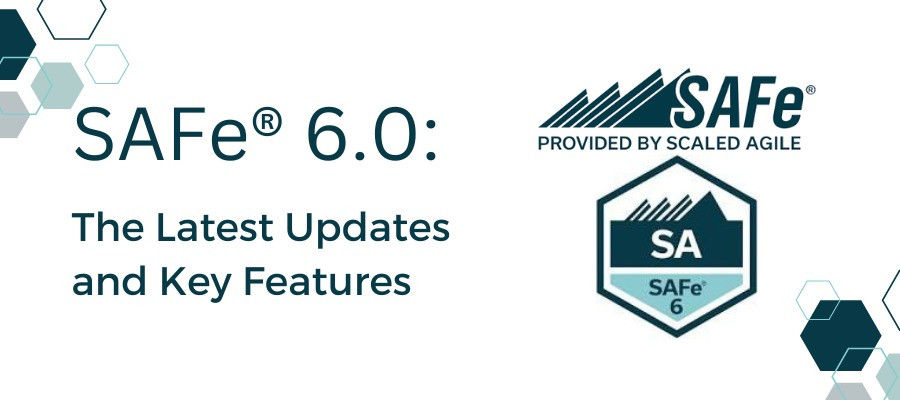SAFe® 6.0: The Latest Updates and Key Features for Scaling Agile in Large Organizations

SAFe® is a framework that enables organizations to implement Agile practices throughout their enterprise. It has continuously evolved since its inception in 2011, adapting to emerging practices and market changes.
Recently, SAFe® Inc. launched its newest version, SAFe® 6.0, introducing significant changes to help organizations achieve business agility. In this article, we will explore the updates and refinements of SAFe® 6.0 and their implications for organizations utilizing the framework. The following are the main changes:
Six Latest Updates of SAFe® 6.0
As SAFe® 6.0 brings in several updates and enhancements to the Scaled Agile Framework, it is worth noting that these changes range from minor to significant. While some changes may have a minor impact on how organizations use SAFe®, others may require a more significant shift in approach. This also affects how SAFe® trainers, consultants, and partners assist organizations in training and Coaching them on SAFe® adoption.
To fully understand the scope of changes, it's best to refer to the official "What's New?" page on the SAFe® website. Here, you can find a comprehensive list of changes with detailed explanations and visuals. Have a look at the latest updates in SAFe® 6.0:
- Accelerating Value Flow on All Levels
SAFe® 6.0 has undergone a significant update that puts a renewed focus on speeding up the flow of value. The framework integrates more Kanban and emphasizes the properties and accelerators of value flow. The ultimate goal is to streamline delivery and ensure customers receive the correct value quickly. This approach applies to all levels of SAFe®, including the team, Agile Release Train (ART), Solution Train, and Portfolio. These updates help organizations quickly respond to market demands and better serve their customers.
- Strengthens the Foundation for Business Agility
The foundation of SAFe® has been updated in version 6.0 to provide greater clarity and emphasis on the two critical elements of Lean and Agile SAFe® now highlights the importance of Lean-Agile principles, practices, and mindset even more strongly and underscores the ultimate goal of Business Agility. This approach enables organizations to become more Agile, adaptive, and customer-centric, ultimately improving business outcomes.
- Objectives and Key Results (OKR) Methodology
SAFe® 6.0 has integrated the Objectives and Key Results (OKR) methodology, enabling organizations to align their strategic goals with day-to-day operations and track progress toward achieving those objectives. This approach ensures that teams work on the right priorities and deliver value aligned with the organization's vision and mission.
- Business Agility Across the Organization
In addition to the updates mentioned above, SAFe® 6.0 underscores the importance of business agility across all aspects of an organization. The framework adds articles covering this topic, such as the Business and Technology article, which provides insights into implementing business agility not only within development teams but also throughout the entire organization.
- Clarifies Roles and Terminology
SAFe® 6.0 further clarifies the responsibilities of various roles within the framework, helping team members better understand their roles and responsibilities. This approach ensures more effective and efficient implementation of the Scaled Agile Framework. The framework also streamlines its use of terminology, for instance, by using only the term "Agile Release Train (ART)" instead of "Program" to avoid confusion.
- Integrates Concepts from AI, Big Data, and Cloud Computing
SAFe® 6.0 incorporates concepts from Artificial Intelligence (AI), Big Data, and Cloud computing to keep up with technological advances. This approach reflects the need for organizations to embrace cutting-edge technologies to maintain a competitive edge in the market.
Critical Features for Scaling Agile in Large Organizations
Improved Collaboration:
Scaling Agile with SAFe® brings people together from different departments and teams, encouraging them to work collaboratively towards a common goal. This increased collaboration fosters a sense of community, promotes knowledge-sharing, and breaks down silos between teams.
Enhanced Transparency:
SAFe® provides a transparent view of all aspects of the development process, including progress, dependencies, and impediments. This transparency enables teams to identify and address issues quickly, which can lead to faster resolution times and a reduction in wasted effort.
Greater Flexibility:
The flexibility provided by SAFe® allows organizations to adapt to changing customer needs, market conditions, and emerging technologies. By providing the tools to respond quickly to changes, SAFe® enables organizations to stay ahead of the curve and deliver value faster.
Improved Business Outcomes:
The ultimate goal of scaling Agile with SAFe® is to deliver business outcomes that matter. By aligning teams around a shared vision and focusing on customer needs, SAFe® enables organizations to achieve better business outcomes, such as increased revenue, improved customer satisfaction, and faster time-to-market.
Conclusion
SAFe®6.0 introduces many updates and improvements that augment the Scaled Agile Framework, enabling organizations to embrace agility, enhance customer focus, and stay ahead in today's market.
This latest version accelerates the flow of value, provides more clarity on role responsibilities and terminology, strengthens business agility, integrates modern technologies and OKR, and offers a comprehensive solution for organizations looking to succeed in an ever-changing business environment. With a keen emphasis on business agility throughout the organization, SAFe® 6.0 aligns all business aspects, ready them to adapt to an evolving market.
Reference
- https://scaledagileframework.com/whats-new-in-safe-6-0/
- https://www.cprime.com/resources/blog/whats-new-in-safe-6-0-and-why-does-it-matter/



